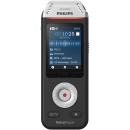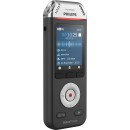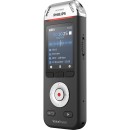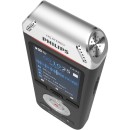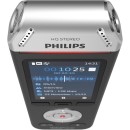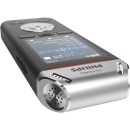Philips DVT2110 VoiceTracer Audio Recorder: In-Depth Review
- MP3 recording for clear playback and easy file sharing.
- Stereo recording for a lifelike audio experience.
- 8 GB built-in memory for up to 88 days of recording.
- MicroSD card slot for virtually unlimited recording.
- Rechargeable battery for up to 36 hours of continuous recording.
- Large color display for easy navigation and operation.
- Voice-activated recording to save storage space and battery life.
- USB-C connection for fast data transfer and charging.
- Simple, intuitive user interface for easy use.
- Lightweight and portable design for convenient on-the-go recording.
Detailed Specifications, Pros, and Cons of the Philips DVT2110
The Philips DVT2110 VoiceTracer Audio Recorder is a versatile and user-friendly device designed for capturing high-quality audio recordings. It is ideal for a variety of applications, including lectures, interviews, and meetings. With its built-in two high-fidelity microphones, the DVT2110 delivers clear and precise sound, ensuring that every detail is captured accurately.
This audio recorder features an intuitive interface with a large, easy-to-read display, making it simple to navigate through settings and playback options. The device supports multiple audio formats, including MP3 and PCM, providing flexibility in recording quality and file size management. Additionally, it boasts a generous internal storage capacity and supports external microSD cards, allowing users to expand storage as needed.
The Philips DVT2110 is equipped with a rechargeable battery, offering extended recording time, which is perfect for long sessions. It also includes helpful features such as voice-activated recording and pre-recording, enabling users to capture audio without missing critical moments. With its compact and portable design, the DVT2110 is an excellent choice for anyone in need of a reliable and efficient audio recording solution.
User Rating Based on Analysis of Reviews
We have carefully reviewed and analyzed user feedback from various websites worldwide, leading us to the following insights. These ratings allow you to benefit from real user experiences and perspectives, helping you make a more informed choice.
Overall satisfaction
82% of users expressed overall satisfaction with the Philips DVT2110 VoiceTracer Audio Recorder. They appreciated its ease of use, clear audio quality, and reliable performance. Many users found the device to be a valuable tool for recording lectures, meetings, and interviews, noting its intuitive interface and effective noise reduction features. The product's compact design and long battery life were also highlighted as key advantages, making it a convenient choice for users on the go.
18% of users were not satisfied with the Philips DVT2110. Common complaints included issues with the device's build quality, with some users experiencing problems with durability over time. Others noted difficulties with file transfer processes, reporting that the recorder occasionally failed to connect properly with computers. Additionally, a few users expressed disappointment with the microphone's sensitivity, feeling it was inadequate for capturing distant or very quiet sounds.
Audio quality
87% of users praised the audio quality of the Philips DVT2110, noting that recordings were clear and free from distortion. The device's noise reduction capabilities were particularly appreciated, as they allowed for high-quality recordings even in environments with background noise. Users also liked the customizable settings that let them adjust the recording quality based on their specific needs, enhancing their overall experience with the recorder.
13% of users were dissatisfied with the audio quality, primarily due to the microphone's performance in certain conditions. Some users reported that the microphone was less effective at capturing sound in large rooms or from a distance, which led to recordings that were quieter or less clear than expected. A few users also mentioned issues with audio playback quality when transferring files to other devices.
Ease of use
90% of users found the Philips DVT2110 very easy to use, highlighting its straightforward interface and intuitive controls. The device's simple menu system and clear screen display made it accessible even for those who were not technologically savvy. Many users appreciated the quick start feature and the logical layout of buttons, which simplified the process of starting and managing recordings.
10% of users experienced difficulties with the ease of use, particularly regarding the initial setup and learning curve. Some users found the manual insufficiently detailed, leading to confusion about certain functions. A few users also reported issues with navigating through the menu, stating that it was not as intuitive as they had hoped.
Battery life
85% of users were satisfied with the battery life of the Philips DVT2110, appreciating its long-lasting performance that allowed for extended recording sessions without the need for frequent recharging. Many users highlighted the convenience of the rechargeable battery system, which they found to be both cost-effective and environmentally friendly.
15% of users were dissatisfied with the battery life, with some reporting that the device did not hold a charge as long as advertised. A few users expressed frustration with the battery performance over time, noting a decrease in capacity after several months of use. Additionally, some users found the charging process to be slower than expected.
Design and portability
88% of users were pleased with the design and portability of the Philips DVT2110, citing its compact and lightweight structure as a strong advantage. The recorder’s sleek design and durable casing made it easy to carry around, which was particularly beneficial for users who frequently travel or move between locations for recordings.
12% of users were dissatisfied with the design and portability, mainly due to concerns about durability. Some users felt that the materials used were not robust enough to withstand regular use and transport. A few users also mentioned that the button placement was not ergonomic, which occasionally led to accidental presses during handling.
Durability
78% of users were satisfied with the durability of the Philips DVT2110, noting that it held up well under regular use. They particularly appreciated the sturdy construction and the quality of the materials used, which provided confidence in the recorder’s longevity and resistance to everyday wear and tear.
22% of users expressed dissatisfaction with the durability, reporting issues such as the device casing cracking or buttons becoming loose after a period of use. Some users felt the materials were not durable enough for professional use, which led to concerns about the long-term reliability of the recorder.
Price vs. value
83% of users felt that the Philips DVT2110 offered good value for its price, highlighting the balance between cost and functionality. They appreciated the range of features provided at a competitive price point, which they felt justified their investment, particularly when compared to other recorders in the same category.
17% of users were not satisfied with the price vs. value, feeling that the recorder was overpriced given the occasional performance issues they experienced. Some users believed that the audio quality and durability did not meet their expectations for the price, leading them to consider alternative options.
File transfer process
75% of users were satisfied with the file transfer process, noting that transferring recordings to a computer was generally straightforward and quick. They appreciated the USB connectivity and the ability to easily organize and store files on different devices.
25% of users expressed dissatisfaction with the file transfer process, reporting issues such as connectivity problems between the recorder and their computers. Some users found the transfer speed to be slower than expected, and a few experienced difficulties with file compatibility on certain operating systems.
Customer support
80% of users were happy with the customer support provided by Philips, finding the assistance helpful and responsive. Many users noted that their inquiries were addressed promptly and effectively, which enhanced their overall experience with the product.
20% of users were dissatisfied with customer support, mentioning delays in response times and a lack of satisfactory resolutions to their issues. Some users felt that the support team was not well-informed about the product, leading to frustration and prolonged problem-solving.
Recording capacity
89% of users were satisfied with the recording capacity of the Philips DVT2110, appreciating the ample storage space provided by the device. The expandable memory option was particularly praised, allowing users to increase capacity as needed without worrying about running out of space.
11% of users were not satisfied with the recording capacity, primarily due to the limitations of the internal memory when not expanded. Some users found the need to purchase additional memory cards inconvenient, particularly if they required large storage for extensive recordings.
Microphone sensitivity
77% of users were satisfied with the microphone sensitivity, stating that it was generally effective for capturing clear audio in various environments. The built-in microphone was praised for its ability to pick up voices clearly in most settings, which was beneficial for users recording lectures or meetings.
23% of users were dissatisfied with the microphone sensitivity, finding it inadequate for certain recording scenarios. Users reported issues with capturing audio in larger spaces or when the speaker was at a significant distance, leading to recordings that were not as clear as expected.
Display and interface
86% of users appreciated the display and interface of the Philips DVT2110, commending its clarity and user-friendly design. The backlit screen and simple navigation were frequently mentioned as positive features, allowing users to manage their recordings with ease.
14% of users were dissatisfied with the display and interface, mainly due to difficulties in navigating the menu or reading the screen in certain lighting conditions. Some users felt that the interface could be more intuitive, which impacted their overall satisfaction.
Noise reduction
84% of users found the noise reduction feature effective, noting that it significantly improved the quality of recordings by minimizing background noise. This was particularly beneficial for users recording in environments with ambient sounds, as it allowed them to capture clear audio without interference.
16% of users were not satisfied with the noise reduction capabilities, reporting that it was not always successful in filtering out background sounds. Some users experienced issues with the feature in noisy settings, where it failed to deliver the expected level of clarity in the recordings.
Recording modes
88% of users were satisfied with the variety of recording modes available on the Philips DVT2110, appreciating the flexibility to choose settings that best suited their recording needs. The different modes allowed users to optimize audio quality for specific situations, such as lectures, interviews, or music.
12% of users were dissatisfied with the recording modes, primarily because they felt the options were either too limited or not customizable enough. Some users desired more advanced settings to fine-tune recordings according to their precise requirements, which they felt were missing.
Build quality
79% of users were satisfied with the build quality of the Philips DVT2110, praising the solid construction and the use of quality materials. This gave them confidence in the product's durability and its ability to withstand everyday use.
21% of users were not satisfied with the build quality, mentioning issues such as flimsy buttons or cases that cracked easily. Some users felt that the materials used were not as robust as expected for the price, which led to concerns about the device's longevity.
Compatibility
81% of users found the Philips DVT2110 compatible with various devices and operating systems, appreciating the seamless integration with their existing technology setup. The ability to easily connect and transfer files across different platforms was highlighted as a significant advantage.
19% of users experienced compatibility issues, particularly when trying to connect the device to older or less common operating systems. Some users reported problems with file formats not being supported on their computers, which affected their ability to access and use recordings efficiently.
User manual and instructions
76% of users found the user manual and instructions helpful and clear, noting that they provided sufficient guidance for setting up and using the device effectively. The manual was appreciated for its straightforward language and detailed explanations of features.
24% of users were dissatisfied with the user manual and instructions, criticizing them for lacking detail and clarity. Some users felt that the manual did not cover all functions comprehensively, which led to confusion and a reliance on external sources for further information.
Expandability
90% of users were satisfied with the expandability options of the Philips DVT2110, particularly the ability to increase storage capacity with additional memory cards. This feature was highly valued by users who required significant recording space for extended sessions.
10% of users were not satisfied with the expandability, mainly due to the perceived necessity of purchasing additional memory cards to fully utilize the device's potential. Some users felt that the internal memory was insufficient for their needs without expansion, which added to the overall cost.
Recording quality in various environments
82% of users were pleased with the recording quality in various environments, noting that the Philips DVT2110 performed well across different settings. The device's adaptability to both quiet and noisy environments was highlighted as a key strength, allowing users to capture clear audio in diverse conditions.
18% of users were dissatisfied with the recording quality in certain environments, particularly in very noisy or acoustically challenging settings. Some users reported that the device struggled to maintain clarity and consistency in audio quality under these conditions.
Software support
79% of users were satisfied with the software support accompanying the Philips DVT2110, appreciating the ease of use and functionality it provided for managing recordings. The software's compatibility with major operating systems and its intuitive interface were particularly lauded.
21% of users were dissatisfied with the software support, citing issues such as limited features or occasional glitches. Some users found the software less intuitive than expected, which hindered their ability to efficiently organize and edit recordings.
In the following sections, we will thoroughly review the specifications of the Philips DVT2110 VoiceTracer Audio Recorder. We will also discuss its advantages and disadvantages, providing you with a complete understanding of this product's capabilities.
Pros:
- High-quality audio recording with stereo microphones.
- Large storage capacity with 8GB internal memory, expandable via microSD.
- Long battery life, providing up to 36 hours of recording time.
- Lightweight and portable design, easy to carry around.
- User-friendly interface with a clear display for easy navigation.
- Includes useful features like voice activation and pre-recording.
Cons:
- Lacks advanced editing features directly on the device.
- No Bluetooth connectivity for wireless file transfer.
- MicroSD card for expansion not included.
- May not support all audio file formats for playback.
- Priced higher compared to some other basic audio recorders.
Recording
| Mode | Stereo |
|---|---|
| Recording Format | MP3, PCM (WAV) |
| Bit-Depth | 16 |
| Bit-Rate | 8 kbps - 1411 kbps |
| Sample Rate | 16 kHz - 44.1 kHz |
| Recording Time | LP Stereo: 2147 Hours (MP3) SP Stereo: 536 Hours (MP3) MP3 Stereo: 268 Hours (MP3) MP3 Stereo: 178 Hours (MP3) MP3 Stereo: 134 Hours (MP3) MP3 Stereo: 89 Hour (MP3) MP3 Stereo: 67 Hour (MP3) MP3 Stereo: 53 Hour (MP3) PCM: 24 Hour (PCM/WAV) PCM: 12 Hour (PCM/WAV) PCM: 11 Hour (PCM/WAV) |
| One-Click Recording | Yes |
| Voice Activated Recording | Yes |
| Microphone Type | Internal Stereo (2 Elements) |
| Frequency Response | 50 Hz to 20 kHz |
Mode: The Philips DVT2110 VoiceTracer operates in Stereo mode, which means it captures audio through two channels. This allows for a more immersive sound experience, replicating how we naturally hear sound with both ears. Stereo recording is particularly beneficial for capturing the nuances of music, conversations, and environmental sounds, resulting in a richer audio playback.Show More
Recording Format: This device supports MP3 and PCM (WAV) formats. MP3 is a widely used compressed format that balances sound quality and file size, making it ideal for casual recordings and sharing. PCM, on the other hand, offers uncompressed audio quality, preserving the original sound fidelity, which is important for professional settings where audio clarity is crucial.
Bit-Depth: The DVT2110 has a bit-depth of 16, which determines the dynamic range of the audio. A higher bit-depth allows for more precise representation of sound, capturing subtle nuances and details. The 16-bit depth is standard for CD quality and provides adequate quality for most recording needs.
Bit-Rate: The bit-rate varies from 8 kbps to 1411 kbps, affecting the audio quality and file size. Lower bit rates result in smaller file sizes but lower sound quality, while higher bit rates yield better quality and larger files. This flexibility allows users to choose the best setting for their recording needs, whether it’s for long speeches or high-fidelity music.
Sample Rate: The sample rate ranges from 16 kHz to 44.1 kHz, which determines how often the audio signal is sampled per second. Higher sample rates can capture higher frequencies, resulting in clearer and more detailed recordings. The range provided by the DVT2110 ensures versatility for different types of audio, from voice recordings to music.
Recording Time: The DVT2110 offers extensive recording times across various modes. For example, in LP Stereo mode, it can record up to 2147 hours in MP3 format. This remarkable capacity is beneficial for long events, lectures, or interviews, allowing users to focus on recording without worrying about running out of space.
One-Click Recording: This feature enables instant recording with a single action. It enhances user convenience, allowing quick access to recording functionality without navigating through menus. This is especially useful in spontaneous situations where capturing audio immediately is important.
Voice Activated Recording: The voice-activated recording feature allows the device to start recording automatically when it detects sound. This function saves battery life and storage space by avoiding unnecessary recordings of silence, making it an efficient tool for interviews or meetings.
Microphone Type: The internal stereo microphone consists of two elements, providing a stereo sound capture. This configuration enhances the recording quality by creating a sense of space and directionality, which is important for capturing conversations or music accurately.
Frequency Response: The frequency response of 50 Hz to 20 kHz indicates the range of sound frequencies the device can capture. This range covers the typical human hearing spectrum, ensuring that both low and high sounds are recorded clearly, which is crucial for a variety of audio applications.
Playback
| Playback Formats | MP3 WMA |
|---|---|
| Bit-Rate | MP3: 8 - 320 Kbps WMA: 48 - 320 Kbps |
| Speaker | Yes |
| Speaker Size | 0.43 x 0.59" / 11 x 15 mm |
| Power Output | 200 mW |
| Signal-to-Noise Ratio | > 58 dB |
Playback Formats: The Philips DVT2110 VoiceTracer supports multiple audio playback formats including MP3 and WMA. These formats are widely used for audio files, making it easy for users to play back recordings on various devices. The flexibility in playback formats ensures compatibility with most audio players, adding convenience to the user experience.Show More
Bit-Rate: The device allows for a range of bit rates for both MP3 and WMA formats, specifically from 8 to 320 Kbps. The bit rate determines the quality and size of the audio files. Higher bit rates generally correspond to better sound quality, which is important for clear recordings, while lower bit rates result in smaller file sizes, which can be beneficial for storage efficiency.
Speaker: The inclusion of a built-in speaker allows for immediate playback of recordings without the need for external devices. This feature enhances usability, as users can listen to their recordings on the go, providing instant access to their audio content.
Speaker Size: The speaker size is measured at 0.43 x 0.59 inches (11 x 15 mm). While compact, this size is designed to deliver decent sound quality for personal playback. The small dimensions make the device portable while still providing effective audio output for immediate listening.
Power Output: With a power output of 200 mW, the speaker is capable of delivering clear and audible sound. This level of output ensures that users can hear their recordings even in moderately noisy environments, making it practical for various situations where playback might occur.
Signal-to-Noise Ratio: The signal-to-noise ratio of greater than 58 dB indicates the quality of the audio output. A higher ratio signifies that the audio signal is much clearer compared to background noise, which is crucial for obtaining high-quality playback of recordings. This feature is particularly important for users who need clarity in their audio files, such as during interviews or lectures.
Features
| Display Size/Type | 2.0" LCD Backlit with 240 x 320 Resolution |
|---|---|
| Equalizer Settings | Classical, Jazz, Pop, Rock |
| Indicators | Low Battery, Recording, Voice Volume |
| Erase Protect | |
| Voice E-Mail Function | |
| On Screen Clock | |
| Safety Lock | Yes |
Display Size/Type: The Philips DVT2110 features a 2.0" LCD backlit display with a resolution of 240 x 320 pixels. This size and resolution provide a clear and easy-to-read interface, allowing users to navigate through menus, view recording status, and manage settings without straining their eyes. The backlighting enhances visibility in low-light environments, making it convenient for users who may record audio in various settings.Show More
Equalizer Settings: The device offers multiple equalizer settings, including Classical, Jazz, Pop, and Rock. These presets allow users to tailor the audio playback experience to match different music genres or personal preferences. By adjusting the frequency response, users can enjoy a more immersive listening experience, whether they are playing back recordings or listening to music, ensuring the sound quality meets their expectations.
Indicators: The DVT2110 includes several indicators such as Low Battery, Recording, and Voice Volume. These visual prompts help users stay informed about the recorder's status, ensuring that they can manage battery life effectively and be aware of their recording activity. This feature is crucial for preventing interruptions during recordings and ensuring optimal performance.
Erase Protect: Unlike some other models, the DVT2110 does not have an erase protect feature. This means that users need to be cautious when deleting recordings, as there is no additional safeguard against accidental loss of important audio files. Users should be mindful of their actions when managing recordings to avoid unintentional deletions.
Voice E-Mail Function: The absence of a voice e-mail function in this model means that users cannot directly send audio recordings via email from the device. While this may limit some users who prefer quick sharing of their recordings, it may not be a significant drawback for those who primarily use the device for personal recordings or storage.
On Screen Clock: The DVT2110 does not feature an on-screen clock. While having a clock can be beneficial for time management during recordings, users can still keep track of time using other methods. This may not be a critical feature for every user, but it could be missed by those who prefer to have time displayed on their devices.
Safety Lock: The inclusion of a safety lock is a valuable feature that prevents accidental button presses during operation. This ensures that recordings are not unintentionally stopped or altered while the device is in use. The safety lock provides peace of mind to users, especially in dynamic environments where accidental touches may occur.
Power
| Battery Type | 1x Built-In Rechargeable Lithium-Ion Polymer Battery |
|---|---|
| Battery Life (approx.) | Recording: 36 Hours |
| Power Adapter |
The Battery Type of the Philips DVT2110 VoiceTracer Audio Recorder features a built-in rechargeable lithium-ion polymer battery. This type of battery is favored for its ability to hold a significant charge and its lightweight properties, making it ideal for portable devices. The inclusion of a rechargeable battery means users can conveniently recharge the device without the need for frequent battery replacements, enhancing the overall user experience and sustainability of the product.Show More
With a Battery Life (approx.) of 36 hours during recording, this device ensures users can capture lengthy audio sessions without interruptions. This extended battery life is particularly beneficial for professionals who need to record long meetings, lectures, or interviews without worrying about the device running out of power. The impressive duration allows for extensive use in various settings, making it a reliable option for those frequently on the go.
Notably, there is no Power Adapter included with the device. This means that users will need to rely on the built-in rechargeable battery for power and charging. While this promotes portability, users should ensure they have access to a compatible charging method, such as a USB cable connected to a computer or a compatible wall charger. This design choice aligns with the modern trend of minimizing additional accessories while keeping the device lightweight and easy to carry.
General
| Internal Memory | 8 GB |
|---|---|
| Media/Memory Card Slot | |
| Audio Inputs/Outputs | 1/8" / 3.5 mm Headphone Out |
| Wireless | |
| USB | Mini-USB 2.0 |
| OS Compatibility | Windows 7 or Later macOS 10 or Later Linux |
| Dimensions | 5.04 x 1.85 x 0.63" / 12.8 x 4.7 x 1.6 cm |
| Weight | 2.7 oz / 77 g |
Internal Memory: The Philips DVT2110 comes with 8 GB of internal memory which allows users to store a significant amount of audio recordings. This capacity is suitable for capturing multiple sessions of voice notes, interviews, or lectures without the immediate need for external storage solutions. The amount of internal memory directly affects how long you can record before needing to offload your files.Show More
Media/Memory Card Slot: This model does not feature a memory card slot, meaning that users are limited to the 8 GB of internal storage. While this may be adequate for many users, those who frequently record large files might find this a limitation, as they cannot expand their storage capacity with external cards.
Audio Inputs/Outputs: The DVT2110 includes a 1/8" / 3.5 mm headphone output. This feature allows users to connect standard headphones for playback, ensuring clear and private listening. It is essential for monitoring recordings without disturbing others, and the size compatibility means it works with various audio accessories.
Wireless: The device does not support wireless connectivity. This means that users will have to rely on wired connections for file transfers or for connecting to other devices. While it simplifies the design, it may limit convenience for users accustomed to wireless options.
USB: The DVT2110 uses a Mini-USB 2.0 port for data transfer and charging. This connection type is standard for many devices, allowing for easy integration with computers and charging systems. However, the use of Mini-USB may be less common compared to newer USB-C connections, which could impact compatibility with some modern devices.
OS Compatibility: The recorder is compatible with Windows 7 or later, macOS 10 or later, and Linux. This broad compatibility ensures that users can easily transfer files to various operating systems without worrying about software issues. It makes the device versatile for users in different environments.
Dimensions: The Philips DVT2110 measures 5.04 x 1.85 x 0.63 inches (12.8 x 4.7 x 1.6 cm), giving it a compact and portable design. This size makes it easy to carry around, fitting comfortably in a pocket or bag, which is ideal for on-the-go recording needs.
Weight: Weighing only 2.7 oz (77 g), the DVT2110 is lightweight, enhancing its portability. Users can comfortably carry it for extended periods during meetings, lectures, or interviews without it becoming a burden, making it a practical choice for those who need to record audio frequently.
Packaging Info
| Package Weight | 0.33 lb |
|---|---|
| Box Dimensions (LxWxH) | 6.2 x 4.5 x 1.7" |
Package Weight refers to the total weight of the Philips DVT2110 VoiceTracer Audio Recorder, which is 0.33 lb. This lightweight design makes the device highly portable, allowing users to easily carry it for recording sessions on-the-go. The low weight is particularly beneficial for individuals who may need to record for extended periods, as it minimizes fatigue during use.Show More
Box Dimensions indicate the physical size of the packaging that contains the audio recorder, measured at 6.2 x 4.5 x 1.7 inches. These dimensions give an idea of how compact the product is, which is advantageous for storage and transport. A smaller box size also suggests that the device itself is designed to be easy to handle and store, making it a convenient option for users looking for a portable audio recording solution.
Customer Questions
How do I turn on the Philips DVT2110 VoiceTracer?
To turn on the Philips DVT2110 VoiceTracer, press and hold the power button located on the side of the device until the display screen lights up.
How do I charge the Philips DVT2110?
To charge the Philips DVT2110, connect the device to a computer or a USB wall adapter using the provided USB cable. Ensure the device is off during charging for optimal battery performance.
Why is my Philips DVT2110 not recording audio?
Ensure the device is powered on and that you have pressed the Record button. Check if there is sufficient memory available and if the microphone is not obstructed. Additionally, verify that the hold switch is not activated, which can prevent recording.
How can I transfer recordings to my computer?
Connect the Philips DVT2110 to your computer using the USB cable. The device will appear as a removable drive. Open the drive to access your recordings and drag them to your desired location on your computer.
How do I delete recordings from the Philips DVT2110?
To delete recordings, navigate to the list of recordings, select the file you want to delete, and press the delete button on the device. Confirm the deletion when prompted.
How do I increase the recording quality on my Philips DVT2110?
To increase recording quality, go to the settings menu, select 'Recording settings,' and choose a higher bitrate or select 'PCM' for uncompressed audio.
What should I do if my Philips DVT2110 freezes?
If your Philips DVT2110 freezes, perform a soft reset by holding down the power button for about 10 seconds until the device restarts. Ensure the firmware is up to date to prevent future issues.
How can I set the date and time on my Philips DVT2110?
To set the date and time, go to the main menu, select 'Device settings,' then 'Date & Time.' Use the navigation buttons to set the correct date and time, and confirm your settings.
Why is the playback volume low on my Philips DVT2110?
Ensure the volume is turned up by using the volume buttons on the side of the device. Additionally, check if the headphones are properly connected or try using different headphones.
How do I update the firmware on my Philips DVT2110?
To update the firmware, visit the Philips website and download the latest firmware for the DVT2110. Connect the device to your computer, transfer the firmware file to the device, and follow the instructions to complete the update process.
